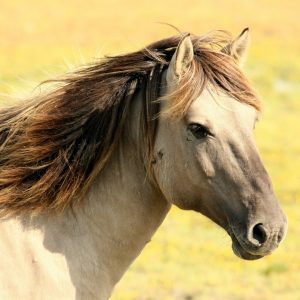The course aims to develop the ability to handle horses using a range of different procedures; skills to evaluate a horses conformation; an understanding of diet; knowledge of grooming procedures; an ability to develop appropriate management procedures; knowledge of commercial opportunities, including trading horses.
E-Learning Structure
The duration of this online course is 100 hours. This consists of 7 in-depth lessons:
- Horse Psychology & Handling
- Buying A Horse
- Conformation
- The Digestive System & Principles Of Feeding & Watering
- The Grass Kept Horse & Pasture Management
- Grooming
- Industry Applications
Course Aims
- Describe different psychological traits of a horse including: *herd instinct *memory *fright.
- Explain how an understanding of horse psychology can assist with handling a horse.
- Compare three different methods of breaking in a horse.
- Demonstrate how to put on different pieces of tack including: *a head stall *a bridle *a saddle.
- Demonstrate how to lead a horse.
- Demonstrate how to ride a horse.
- Develop a list of safety rules for handling horses in a specified situation.
- Compare the differences in the way two different horse owners handle their horses, at the same horse show or competition.
- Describe the different ways of trading (i.e. buying or selling) horses in your locality.
- Develop a checklist of factors to consider when buying a horse for a specified type of use.
- Compare five different advertisements for the sale of horses of a similar type, to determine which of the five appears to be the best value, and listing the reasons why it appears good value.
- Evaluate the features of a horse being offered for sale in your locality, to determine the value of that horse.
- Label an unlabelled diagram of the parts of a horse’s body.
- Define the different conformation terminology, including: *girth *body proportions *leg settings *conformation *bone.
- Describe the preferred features of the parts of a horses body referred to in earlier points.
- Compare the conformation of two different breeds of horses, based upon a physical inspection of a horse from each breed.
- Compare procedures used to evaluate the conformation of horses at two different properties/facilities.
- Label the parts on an unlabelled diagram of the digestive system of horses.
- Explain the function of different components in a horse’s diet.
- Explain how the watering of a horse, as observed by you, on a specific property is likely to affect that horses digestive processes.
- Evaluate the digestive processes involved in the digestion of three different horse feeds analysed by you.
- Differentiate between the digestive processes in three different types of horses, including:
*very active horses *horses being rested. - Compare the advantages with the disadvantages of keeping a horse at grass.
- Recommend paddock facilities, in your locality, which are appropriate for horses kept at grass.
- Prepare a description, and use illustrations where appropriate, of the facilities you recommended.
- Differentiate between the requirements of a specified horse kept at grass, at different times of the year, in your locality.
- Develop guidelines for managing a specific horse at grass, on a property visited and investigated by you.
- Explain three different husbandry tasks which are essential to the management of the horse investigated by you.
- List the different reasons for grooming horses.
- Describe how to use different items of grooming equipment.
- Write a procedure for washing a horse, in a specified situation.
- Compare how to groom horses for different situations, including: *dressage *pony club competition *exhibitions *stock work.
- List the different applications for horses in modern society.
- List the resources available for different sectors of the horse industry in your locality, including: *racing *breeding *competitions *recreational riding.
- Determine the minimum facilities required to establish three different specified businesses in the horse industry, including; *a riding school *a stock agent *another horse business.
- Evaluate the financial viability of four different sectors of the horse industry.
- Evaluate the potential of two different specified horse enterprises in your locality.
How Does A Warnborough Online Course Work?
You can start the course whenever is convenient for you. You will be studying from home and have access to support from our qualified tutors. Practical exercises and research tasks will be set at the end of each lesson – including an assignment. You will submit this assignment to your course tutor, who will mark your work and give you constructive feedback and suggestions.
If you have any questions please contact us.





